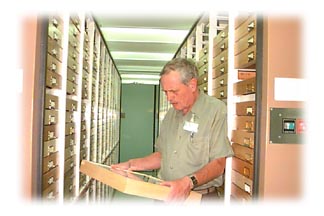| |
|
Wojciech Jerzy Pulawski
 Ph.D. from Wroclaw University,
Poland, 1960. Habilitate Doctor, same University, 1971 (equivalent to the British Doctor of Sciences, higher scientific
degree), Associate Professor, same University, 1980. Smithsonian Fellowship 1974-1975. California Academy of Sciences
Visiting Curator Entomology Department (1981-1983); Assistant Curator (1983-1984), Associate Curator (1984-1992),
Curator (1992 to date), Departmental Chairman (1983-1987, 1993). Editor of Polskie Pismo Entomologiczne (1963 -1981).
President (1996) and Treasurer (1981-1989) of the Pacific Coast Entomological Society. Ph.D. from Wroclaw University,
Poland, 1960. Habilitate Doctor, same University, 1971 (equivalent to the British Doctor of Sciences, higher scientific
degree), Associate Professor, same University, 1980. Smithsonian Fellowship 1974-1975. California Academy of Sciences
Visiting Curator Entomology Department (1981-1983); Assistant Curator (1983-1984), Associate Curator (1984-1992),
Curator (1992 to date), Departmental Chairman (1983-1987, 1993). Editor of Polskie Pismo Entomologiczne (1963 -1981).
President (1996) and Treasurer (1981-1989) of the Pacific Coast Entomological Society.
My major interests include general aspects of evolution and biogeography, principles and methods of classification,
morphological and behavioral evolution of Hymenoptera. Long range goals: monographic revisions of various genera
of Sphecid wasps on global or continental scale, phylogenetic and zoogeographic inference, refinement of family
classification. I have published in Polish, French, Russian, and English. I have conducted fieldwork in Bulgaria,
Caribbean Islands, Egypt, Fiji, Ghana, Hungary, India, Italy, Ivory Coast, Kazakhstan, Madagascar, Mali, Mauritania,
Mexico, Namibia, Pakistan, Papua New Guinea, Peru, Poland, Senegal, Tajikstan, Thailand, Togo, Turkmenistan, USA,
Zambia, and Zimbabwe. I have visited museums in Berlin, Bruxelles, Budapest, Cape Town, Dresden, Eberswalde, Frankfurt,
Genova, Honolulu, Lausanne, Leiden, Leningrad, London, Moscow, Munich, Napoli, Ottawa, Oxford, Paris, Pretoria,
Tervuren, Torino, Vienna, Washington, D.C., Zurich. Current research project: a revision of the African wasp genera
Tachysphex (supported by National Science Foundation). My major accomplishments are:
1. A revision of European Astatinae (1957). This is the most complete paper on the European species,
based on previously known and newly discovered diagnostic characters. Original keys for identifications are provided.
2. A monograph of Palearctic Tachytes (1962). The study covered 56 European, North African, and Soviet
Middle Asian species, and dealt with natural history as well as systematics.
3. Studies on the World Tachysphex. With over 393 described and many undescribed species, this is one
of the largest and most difficult genera among the Sphecidae. I revised the Palearctic (1971), South American (1974),
Australian (1977), and North American species (1988), and I co-authored a paper on Sri Lankan and other Asian species
with Karl V. Krombein of the Smithsonian Institution (1995). The revision of North American species won the Award
from the American Association of Museums for its Scanning Electron Micrographs. I concluded that abiotic factors
were important in the speciation of Tachysphex, but that supraspecific evolution depended largely on changes
in behavior (e.g., if a female wasp adapts to a new prey type).
4. A revision of the Old World Parapiagetia (1977), World Prosopigastra (1979),
World Kohliella (1991), World Holotachytes (1992), and World Tachytella (1995). All species
in each genus were studied, including life histories and distributions, and newly discovered characteristics permitted
a significant refinement of the generic classification of the subfamily Larrinae. Numerous new species have been
described.
5. A revision of the World Gastrosericus (1995). This is probably my best and most modern publication,
based on museum material and extensive fieldwork in Asia and Africa.
6. I coauthored a study on a fossil wasp, Pison electrum, from Baltic amber; and another, Pison antiquum,
from Dominican amber.
7. Contributions to keys. I have published several fascicles on different families of aculeate wasps
in the Keys to the Identification of Polish Insects (1958, 1960, 1963, 1967), and also wrote the Sphecidae
section in Keys to Hymenoptera of European USSR. This is the largest key ever published on European Sphecidae,
and covers the largest area and greatest number of species.
6. Annotated lists of Bulgarian (1958), Egyptian (1964), and Turkish (1967) Sphecidae,
with description of new species.
Pulawski, W.J. 1962. Les Tachytes Panz. de la région paléarctique occidentale et centrale
(Hym., Sphecidae). Polskie Pismo Entomologiczne. 32:311-475.
__________. 1971. Les Tachysphex Kohl (Hym., Sphecidae) de la région paléarctique occidentale
et centrale. Panstwowe Wydawnictwo Naukowe, Wroclaw. 464 pp.
__________. 1974. A revision of the Neotropical Tachysphex (Hym., Sphecidae). Polskie Pismo Entomologiczne.
44:3-80.
__________. 1979. A revision of the World Prosopigastra Costa (Hymenoptera, Sphecidae). Polskie Pismo
Entomologiczne. 49:3-134.
__________. 1988. Revision of North American Tachysphex wasps including Central American and Caribbean
species (Hymenoptera: Sphecidae. Memoirs of the California Academy of Sciences 10: 1-211.
__________. 1989. (with A.V. Antropov as senior author). A new species of Pison from Baltic amber (Hymenoptera:
Sphecidae). Pan-Pacific Entomologist 65: 312-318.
__________. 1991a. A revision of the wasp genus Kohliella (Hymenoptera: Sphecidae). Proceedings of the
California Academy of Sciences 47 (10):289-302.
__________. 1991b. A review of Eremiasphecium Kohl, 1897 (Hymenoptera: Sphecidae). Entomofauna 13:397-408.
__________. 1992a. World species of the wasp genus Holotachysphex de Beaumont (Hymenoptera: Sphecidae).
Proceedings of the Entomological Society of Washington 94 (2):223-242.
__________. 1992b. (with H.K. Court as junior author). A review of the genus Hingstoniola (Hymenoptera:
Sphecidae: Crabroninae). Journal of Hymenoptera Research 1:255-260.
__________. 1994. (with K.V. Krombein, K.V. as senior author). Biosystematic studies of Ceylonese wasps, XX:
a revision of Tachysphex, Kohl, 1883, with notes on other Oriental species (Hymenoptera: Sphecidae: Larrinae).
Smithsonian Contributions to Zoology 552:1-106.
__________. 1995b. The wasp genus Gastrosericus Spinola, 1839 (Hymenoptera: Sphecidae). Memoirs of the
California Academy of Sciences. 18:i-vi, 1-173.
__________. 1996. (with A.V. Antropov as senior author). Pison antiquum, a new species from Dominican
amber (Hymenoptera: Sphecidae). Journal of Hymenoptera Research 5:16-21.
|